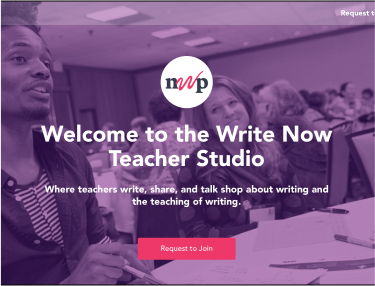Discover Content
Results for “Argument”
MAPS Planner for Writing to a Public Audience
The MAPS planner, inspired by the work of Dawn Reed and Troy Hicks, was created as part of a collection of resources for NWP's College, Career, and Community Writers Program (C3WP). The planner is designed to support students in thinking about the specific rhetorical situation for going…
A Cycle of Discussion and Inquiry
This chapter, from Thomas M. McCann's Transforming Talk into Text: Argument Writing, Inquiry, and Discussion, Grades 6-12, traces the sequence of discussions in a 9th-grade English class, as the teacher moved the learners toward writing an academic essay and reading related texts critically.
Journalism and Argument Writing
Help students understand how to do background research and write an effective pitch for an article on a given topic.
An Evolving Writing Classroom
Seth Mitchell explains the ways in which digital writing transformed his teaching of writing. Included are examples of students’ digital stories and detailed explanation of how this transformation came about.
Amplifying Student Voices
Dave Boardman makes the argument that writing online not only makes writing digital, it transforms it into interactive, changeable communication. He tells the story of inviting his students to participate in an online community with other writers across the country and includes references…
Measuring Civic Writing: The Development and Validation of the Civically Engaged Writing Analysis Continuum
This article examines the conceptual underpinnings and development process of the Civically Engaged Writing Analysis Continuum (CEWAC), a tool developed by the National Writing Project for assessing youth's civically engaged writing. It also makes the case for CEWAC as a powerful tool both…
Teaching Informed Argument for Solution-Oriented Citizenship
In this article, Casey Olsen, a high-school teacher involved in NWP's College, Career, and Community Writers Program (C3WP), describes an approach to teaching argument that helps his students "develop understandings and skills that change the way they experience the conversations that…
In Common: Effective Writing for All Students; A Collection of K-12 Argument/Opinion Writing Samples
This collection, available online or as a PDF, contains a wide variety of K-12 student argument and opinion writing samples, accompanied by annotations using the language of the Common Core State Standards. These samples could be useful for professional development or teacher inquiry, or as…
Creating Multimedia Persuasive Commentaries: Adaptable Resources from Let’s Talk About Election 2020
This resource contains materials and discussions originally created for the KQED Let’s Talk About Election 2020 campaign, but would be useful to anyone who is looking to give students an opportunity to engage in topics, issues, and/or controversies that are relevant to their lives and their…
Modernizing the Old School Essay
How can we rethink writing instruction to support students in writing authentic pieces about real world issues that matter to them? How can we move beyond the "old school essay" and invite students to write compositions that reflect what we see in real world writing? In Real Writing:…
Should We Teach the Five-Paragraph Essay?
When teaching tools like the five-paragraph essay shift from useful foundation to unnecessary restriction, students' abilities to expand on ideas in analytical and creative ways can be hampered. Josh Boldt, who teaches writing at the University of Georgia in Athens, shares his thoughts.
Considering the 5-Paragraph Essay
The 5-paragraph essay: it is frequently derided, but hard to avoid. This collection explores the critique of the 5-paragraph essay, and considers how we could move beyond it to more creative and authentic forms of academic writing.
Write Now Teacher Studio

Where teachers write, share, and talk shop about writing and the teaching of writing
Hosted by the National Writing Project, the Write Now Teacher Studio is an open, online community of educators for educators. It’s a place to write together, examine our teaching, create and refine curricula, and work toward ever more effective and equitable practices to create confident, creative, and critical thinkers and writers in our classrooms and courses.

